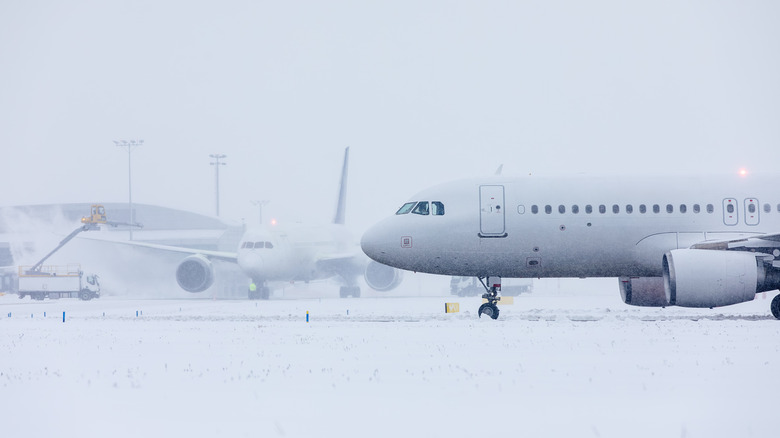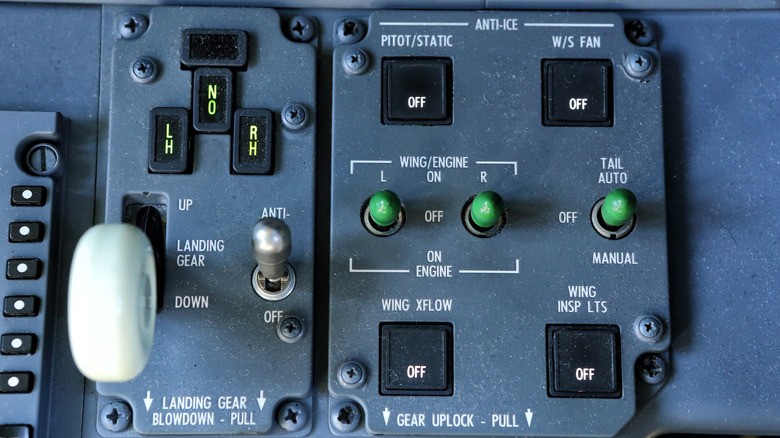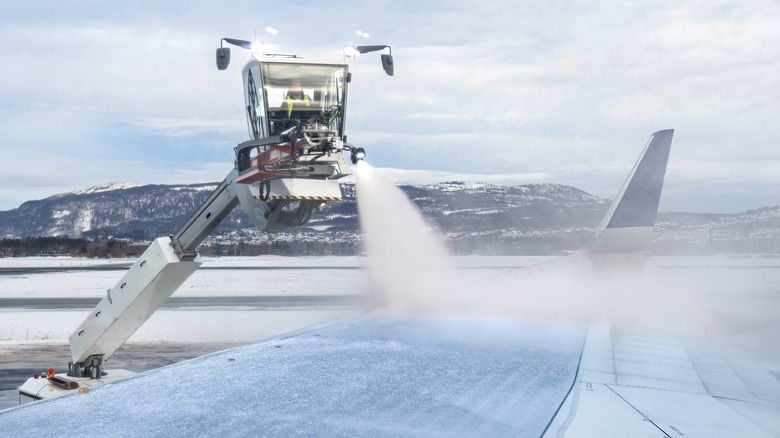Anti-Icing Vs. De-Icing Commercial Jets: What's The Difference?
Freezing temperatures are one of the many mortal enemies of safe air travel, and we're not just talking about jets trying to land on icy runways. A little frost might not sound like a big deal, but it only takes a bit of ice buildup in the wrong place to hinder a plane's critical safety and operational equipment. Ice buildup can throw off a plane's weight, block up engines and propellers, increase drag and friction on the body and wings, and more. Any one of these conditions could lead to a disaster, and in fact, there have been multiple aircraft emergencies and crashes directly attributed to ice buildup.
In order to prevent these disasters from manifesting, modern aircraft are equipped with an arsenal of frost-busting implements. These implements can be broadly sorted into two categories: anti-icing and de-icing. The former is meant to prevent ice from forming and accumulating on the plane's body and inside its vital components, while the latter is meant to swiftly remove any ice that has accumulated. Both of these functions can be accomplished through a variety of ice-melting methods, including heat circulation, chemical agent sprays, and more. The primary difference is the point in a flight at which these systems are activated.
Anti-icing systems are designed to prevent ice from forming at all
Pilots already have enough on their plate during any given flight, so it would be ideal if they didn't have to put up with errant ice weighing them down on top of all that. This is why one of the two primary ice removal frameworks for commercial jets is anti-icing. As the name implies, the purpose of an anti-icing system is to prevent ice from forming on the plane in the first place. It's a proactive measure that's typically activated before a plane flies into projected low-temperature conditions like a cold front or ice storm.
There are a few different ways an anti-icing system can go about its work. The first and most obvious is a heating element. A thermal anti-icing system utilizes heat generated either by the plane's own jet engines or a dedicated electronic system, which is then circulated to critical external surfaces. A little heat in the right place will prevent those spots from getting cold enough for ice to form. A similar offshoot of this is an electrical resistance system, which utilizes electric heating elements embedded right into critical spots like engine intakes. This particular framework gives pilots a greater degree of control over where the heat goes.
Besides heating elements, jets can also have chemical-based anti-icing systems, which utilize sprays of formulated antifreeze similar to the spray you might use to defrost your car's windshield. This will lower ambient freezing points, preventing water particles from hardening into ice, as well as create slick surfaces that ice can't cling to. These chemicals are typically circulated through small holes on the leading edges of the wings. The little tear-like droplets that fall out during this process gave rise to this system's nickname, the "weeping wings."
De-icing systems are designed to remove ice after it forms
Where anti-icing systems are typically employed ahead of a voyage into icy conditions to prevent ice from forming, de-icing systems are meant to deal with ice that's already taken shape. These kinds of systems are used after a plane has already landed to remove any accumulated ice, though they can also be deployed mid-flight in a pinch.
De-icing systems use many of the same tricks from the anti-icing playbook, including strategically-placed heating elements and chemical agents. The difference is that the systems are designed to quickly sweep away accumulated ice rather than preventing it from forming. For example, with a thermal system, the temperature rapidly rises either from hot air generated by the engine or electrical elements embedded on the wings. This quickly melts any icy patches, which are then swept away by air resistance. Chemical systems once again use the "weeping wings" approach, wherein antifreeze is dispensed along the surface of the wings to loosen up ice patches and carry them away. These chemicals can also be sprayed on directly prior to a flight.
The one major type of approach used exclusively by de-icing systems is a pneumatic boot, effectively an inflatable panel hidden within a plane's wings or tail. When activated, these pneumatic panels are pumped full of air, subtly shifting their shape. Ice is stubborn, yet fragile, and simply changing the shape of the surface it's stuck to will cause it to fall off. Once the ice is gone, the air is sucked back out, and the pneumatic panel returns to its original shape.


